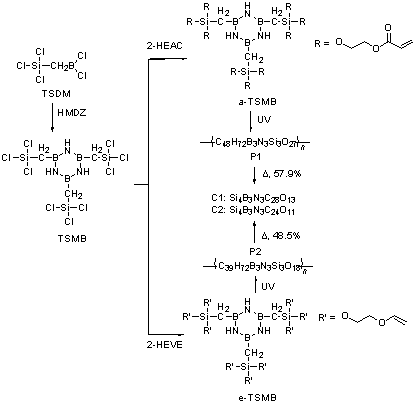1 Riedel, R.; Mera, G.; Colombow, P. J. Am. Ceram. Soc.2010, 93, 1805.2 Riedel, R.; Kienzle, A.; Dressler, W.; Ruwisch, L.; Bill, J. Nature 1996, 382, 796.  3 Kunz, K. P.; Sarin, V. K.; Davis, R. F.; Bryan, R. F. Mater. Sci. Eng. A 1988, 105, 47. 3 Kunz, K. P.; Sarin, V. K.; Davis, R. F.; Bryan, R. F. Mater. Sci. Eng. A 1988, 105, 47.  4 Wang, D.-H.; Jiang, L. The UV Curable Materials, Science Press, Beijing, 2001, pp. 3~7 (in Chinese). (王德海, 江棂, 紫外光固化材料, 科学出版社, 北京,2001, pp. 3~7.)5 Reddy, S. K.; Cramer, N. B.; Cross, T.; Raj, R.; Bowman, C. N. Chem. Mater. 2003, 15, 4257. 4 Wang, D.-H.; Jiang, L. The UV Curable Materials, Science Press, Beijing, 2001, pp. 3~7 (in Chinese). (王德海, 江棂, 紫外光固化材料, 科学出版社, 北京,2001, pp. 3~7.)5 Reddy, S. K.; Cramer, N. B.; Cross, T.; Raj, R.; Bowman, C. N. Chem. Mater. 2003, 15, 4257.  6 Cramer, N. B.; Reddy, S. K.; Lu, H.; Cross, T.; Raj, R.; Bowman, C. N. J. Polym. Sci. Part A: Polym. Chem. 2004,42, 1752. 6 Cramer, N. B.; Reddy, S. K.; Lu, H.; Cross, T.; Raj, R.; Bowman, C. N. J. Polym. Sci. Part A: Polym. Chem. 2004,42, 1752.  7 Li, Y.-H.; Li, X.-D.; Kim, D. P. J. Organomet. Chem. 2007,692, 5303. 7 Li, Y.-H.; Li, X.-D.; Kim, D. P. J. Organomet. Chem. 2007,692, 5303.  8 Li, Y.-H.; Li, X.-D.; Kim, D. P. J. Electroceram. 2009, 23,133. 8 Li, Y.-H.; Li, X.-D.; Kim, D. P. J. Electroceram. 2009, 23,133.  9 Zhang, G.-B.; Kong, J.; Fan, X.-D.; Li, X.-G.; Tian, W.; Huang, M.-R. Appl. Organomet. Chem. 2009, 23, 277. 9 Zhang, G.-B.; Kong, J.; Fan, X.-D.; Li, X.-G.; Tian, W.; Huang, M.-R. Appl. Organomet. Chem. 2009, 23, 277.  10 Zhang, G.-B.; Fan, X.-D.; Kong, J.; Liu, Y.-Y.; Wang, M.-C.; Qi, Z.-C. Macromol. Chem. Phys. 2007, 208, 541. 10 Zhang, G.-B.; Fan, X.-D.; Kong, J.; Liu, Y.-Y.; Wang, M.-C.; Qi, Z.-C. Macromol. Chem. Phys. 2007, 208, 541.  11 Haberecht, J.; Krumeich, F.; Grützmacher, H.; Nesper, R. Chem. Mater. 2004, 16, 418. 11 Haberecht, J.; Krumeich, F.; Grützmacher, H.; Nesper, R. Chem. Mater. 2004, 16, 418.  12 Gervais, C.; Maquet, J.; Babonneau, F.; Duriez, C.; Framery, E.; Vaultier, M.; Florian, P.; Massiot, D. Chem. Mater. 2001,13, 1700. 12 Gervais, C.; Maquet, J.; Babonneau, F.; Duriez, C.; Framery, E.; Vaultier, M.; Florian, P.; Massiot, D. Chem. Mater. 2001,13, 1700.  13 Toury, B.; Miele, P. J. Mater. Chem. 2004, 14, 2609. 13 Toury, B.; Miele, P. J. Mater. Chem. 2004, 14, 2609.  14 Miele, P.; Toury, B.; Cornu, D.; Bernar, S. J. Org. Chem.2005, 690, 2809. 14 Miele, P.; Toury, B.; Cornu, D.; Bernar, S. J. Org. Chem.2005, 690, 2809.  15 Noth, H.; Vahrenkamp, H. Chem. Ber. 1966, 99, 1049. 15 Noth, H.; Vahrenkamp, H. Chem. Ber. 1966, 99, 1049.  16 Jäschke, T.; Jansen, M. C. R. Chimie 2004, 7, 471. 16 Jäschke, T.; Jansen, M. C. R. Chimie 2004, 7, 471.  17 Jäschke, T.; Jansen, M. Z. Anorg. Allg. Chem. 2004, 630,239. 17 Jäschke, T.; Jansen, M. Z. Anorg. Allg. Chem. 2004, 630,239.  18 Jäschke, T.; Jansen, M. J. Eur. Ceram. Soc. 2005, 25, 211. 18 Jäschke, T.; Jansen, M. J. Eur. Ceram. Soc. 2005, 25, 211.  19 Jäschke, T.; Jansen, M. J. Mater. Chem. 2006, 16, 2792. 19 Jäschke, T.; Jansen, M. J. Mater. Chem. 2006, 16, 2792.  20 Gerardin, C.; Henry, M.; Taulelle, F. Mater. Res. Soc. Symp. Proc. 1992, 271, 777. 20 Gerardin, C.; Henry, M.; Taulelle, F. Mater. Res. Soc. Symp. Proc. 1992, 271, 777.  21 Nie, J.; Linden, L. A.; Rabek, J. F. Angew. Makromol. Chem.1998, 257, 47. 21 Nie, J.; Linden, L. A.; Rabek, J. F. Angew. Makromol. Chem.1998, 257, 47.  22 Decher, C. Prog. Polym. Sci. 1996, 21, 593. 22 Decher, C. Prog. Polym. Sci. 1996, 21, 593.  23 Decker, C. J. Macromol. Sci., Pure Appl. Chem. 1997, 34,605. 23 Decker, C. J. Macromol. Sci., Pure Appl. Chem. 1997, 34,605.  24 Seyferth, D.; Köjler, H. P. J. Inorg. Nucl. Chem. 1960, 15,99. 24 Seyferth, D.; Köjler, H. P. J. Inorg. Nucl. Chem. 1960, 15,99.  25 Wideman, T.; Cortez, E.; Remsen, E. E.; Zank, G. A.; Carroll, P. J.; Sneddon, L. G. Chem. Mater. 1997, 9, 2218. 25 Wideman, T.; Cortez, E.; Remsen, E. E.; Zank, G. A.; Carroll, P. J.; Sneddon, L. G. Chem. Mater. 1997, 9, 2218.  26 Trassel, S.; Motz, G.; Rossler, E. J. Non-Cryst. Solids 2001,293/295, 261. 26 Trassel, S.; Motz, G.; Rossler, E. J. Non-Cryst. Solids 2001,293/295, 261.  |
